|
UV GUIDE
UK
Advances
in Reptile Lighting
A
resource for all reptile keepers
|
|
The
Lamp Test Results
|
|
Please
note: This
report was written in 2007 and these test results
refer to the versions of ZooMed Reptisun Compact Lamps,
Big Apple Herpetological Mystic Lamps and R-Zilla
Desert 50 Series lamps which were on sale at that
time.
Since
then, Big Apple have completely withdrawn their "Mystic"
lamps from sale. ZooMed and R-Zilla (now renamed Zilla)
have re-formulated their products and have either
already replaced, or are in the process of replacing,
old stock with the new lamps. These have been designed
with safer phosphors which do not emit "non-terrestrial",
abnormally short-wavelength UVB radiation (see below
for an explanation of this).
We
advise prospective purchasers to ensure that they
are buying the latest version of the product. How
to tell?...
- New
ZooMed Reptisun Compact Lamps
have an information leaflet which includes pictures
and advertising for the Deep Dome Lamp Fixture.
This product is not specifically mentioned on leaflets
in the boxes containing old stock.
- New
Zilla Desert 50 Series and
Tropical 25 Series lamps have pictures of
the spectrum and a "UV Index" chart printed
on their boxes.
We
hope to publish test results for all the reformulated
lamps very soon.
September
2009
|
What
is different about these lamps?
It
was difficult, at first, to understand the reason for the
specific problems with these particular lamps.
Total
UVB output at the manufacturer's recommended basking distances
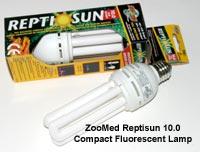 The
ZooMed Reptisun 10.0 Compact Lamp
is described as " ideal for all desert and basking reptiles"
and the 5.0 Compact Lamp
as "ideal for all tropical basking reptiles". No information
is available on the box or on the ZooMed website regarding
any recommended basking distances. ZooMed are now including
a comprehensive information sheet in the packaging of all
new stock, but this was not inside any of the new boxes
we obtained back in April. Hence it seemed, at first, that
maybe the lamps were just being placed too close. However,
we measured the output of their lamps with a broadband UVB
meter (Solarmeter 6.2) and found total UVB levels not unlike
those found in natural sunlight, at distances which caused
eye problems in reptiles. For example, a brand new ZooMed
Reptisun 10.0 Compact Lamp gave a reading of 306
µW/cm² at 6 inches. Reptiles have been recorded basking
and foraging in sunlight in the wild at similar levels (up
to 322 µW/cm²). The reading at 10
inches was 121 µW/cm². The
ZooMed Reptisun 10.0 Compact Lamp
is described as " ideal for all desert and basking reptiles"
and the 5.0 Compact Lamp
as "ideal for all tropical basking reptiles". No information
is available on the box or on the ZooMed website regarding
any recommended basking distances. ZooMed are now including
a comprehensive information sheet in the packaging of all
new stock, but this was not inside any of the new boxes
we obtained back in April. Hence it seemed, at first, that
maybe the lamps were just being placed too close. However,
we measured the output of their lamps with a broadband UVB
meter (Solarmeter 6.2) and found total UVB levels not unlike
those found in natural sunlight, at distances which caused
eye problems in reptiles. For example, a brand new ZooMed
Reptisun 10.0 Compact Lamp gave a reading of 306
µW/cm² at 6 inches. Reptiles have been recorded basking
and foraging in sunlight in the wild at similar levels (up
to 322 µW/cm²). The reading at 10
inches was 121 µW/cm².
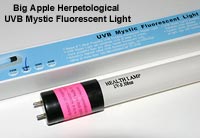 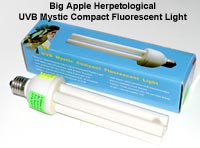 The
Big Apple Herpetological Mystic
lamps are claimed to be "Rated #1 most powerful
UVB emitting fluorescent reptile light" and to "produce
as much UVB as the highest quality UVB mercury vapor bulbs". The
Big Apple Herpetological Mystic
lamps are claimed to be "Rated #1 most powerful
UVB emitting fluorescent reptile light" and to "produce
as much UVB as the highest quality UVB mercury vapor bulbs".
The manufacturers recommend a minimum basking distance of
10 inches if used without a screen between lamp and reptile.
We recorded total UVB levels from a brand new Mystic Compact
Lamp as 128 µW/cm² at 10 inches,
and from a brand new Mystic 24" linear tube as 142
µW/cm² at 10 inches.
The
new R-Zilla Desert 50 Series
are described as "ideal for these desert-dwelling reptiles:
African fat-tailed gecko, leopard geckos, Schneider's skinks,
bearded dragons, nile monitors, tegus, blue-tongue skinks,
red- footed tortoises, uromastyx, emerald swifts and savannah
monitors".
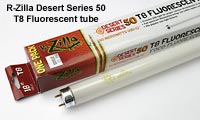 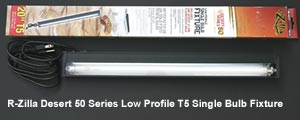 No
minimum basking distance is specified regarding the T8-size
linear tube. We recorded total UVB levels from a 15 watt
tube that had been burned-in for 150 hours as 69
µW/cm² at 10 inches. No
minimum basking distance is specified regarding the T8-size
linear tube. We recorded total UVB levels from a 15 watt
tube that had been burned-in for 150 hours as 69
µW/cm² at 10 inches.
Included with the T5-size "Low Profile Single Bulb Fixture"
(a tube inside a ballasted fixture complete with a UVB-transmitting
acrylic cover sleeve) is a detailed instruction sheet stating
that the lamp unit is "for use over covered terrariums only"
- presumably the cover would be a screen. The recommended
tank sizes are all of maximum height 12 inches, so this
is presumably the suggested maximum distance from the reptile;
a minimum distance is not specified. We recorded total UVB
levels from a brand new T5-size "Low Profile Single Bulb
Fixture" with its acrylic sleeve in place, as 137
µW/cm² at 10 inches.
Thus,
the total UVB output of all these lamps, although high for
fluorescent lamps, does not seem alarming. Natural sunlight
can have a much higher total UVB output (measured in µW/cm²)
than these lamps at reasonable basking distances, and yet
reptiles do not develop photo-kerato-conjunctivitis in natural
sunlight. In addition, there are other types of UVB lamp
available, such as some UVB mercury vapour lamps, which
do not appear to cause photo-kerato-conjunctivitis at distances
where a high, or higher, total UVB level is recorded.
|
|
The
"photobiological activity" of a lamp: measuring the UV Index
The
lower UV wavelengths of sunlight (around and below 300nm)
are much more biologically active than the higher wavelengths
(up to 320nm). It is these lower wavelengths which enable
vitamin D3 synthesis, and in general, the lower the wavelength
of UV light, the greater the potential for damage to skin
and eyes, too.
Could
these lamps have a higher proportion of their UVB in these
lower wavelengths, making their UV light more photobiologically
active - i.e. "stronger" - than sunlight?
Broadband
UVB meters, such as the Solarmeter 6.2, measure the entire
UVB range (280 – 320nm) and give a readout of the total
UVB irradiance in µW/cm². They cannot give any indication
of what percentage of the total UVB is in the more biologically
active, lower wavelengths. Therefore, a simple comparison
of the readings from a broadband meter from the sun and
from a lamp with "stronger" UV light could be misleading
as regards the potential of the lamp to cause cell damage,
photo- kerato-conjunctivitis, or, for that matter, to enable
the synthesis of vitamin D3.
We therefore
needed to find out how much of the UVB from these lamps
was in the more biologically active, lower wavelengths,
and how the output of the lamp at different distances would
compare to natural sunlight. This can be done by measuring
the UV Index (UVI) of
light from the lamp at various distances.
The
UV Index is a universal, unitless measure indicating the
intensity of UVB radiation in the biologically active range
of wavelengths - specifically, the wavelengths that enable
skin synthesis of vitamin D3, cause damage to the DNA of
living cells, and produce erythema (sunburn) in human skin.
It is widely used in assessment of solar radiation -and
even announced on weather forecasts. (1)(2)
We have
just begun to use the Solarmeter 6.5
UV Index Meter to reveal the "photobiological activity"
of different lamps. This meter gives a direct readout of
the UV Index. It has a sensor response which follows the
Diffey Erythemal Action Spectrum effective irradiance (Eeff),
which closely follows the vitamin D action spectrum (Deff)
in the UVB range (280 - 320nm).(3)
In simple terms, the meter "weights" the readings from different
wavelengths, giving a "higher score" to the more biologically
active wavelengths. The final, total "score" is
the UV Index.
When
readings were taken from sample lamps from the three brands
described above, and compared with readings from other lamps
and with solar recordings, the answer was revealed: there
were, indeed, considerable differences.
Figure
6 shows the UV Index for the sun and for a selection of
UVB reptile lamps, recorded with the UV Index Meter at the
distance at which the Solarmeter 6.2 reads exactly 100 µW/cm²
of total UVB.
| Fig.
6 : The relative "photobiological activity" of different
lamps and the sun |
| |
µW/cm²
of total UVB |
UV
Index |
Details
of recording |
| Solar
UV spectrum |
100
µW/cm² |
(1)
1.6
(2)
2.0
|
(1)
07:30 GMT 29 June 2006 – clear sky
(2)
11:30 GMT 28 Aug 2007 – overcast sky
|
| Arcadia
5% UVB D3 Reptile linear tube |
100
µW/cm² |
2.2 |
lamp
ref. BA7 – 105hr use |
| Arcadia
7% UVB D3 Compact Reptile Lamp |
100
µW/cm² |
2.2 |
lamp
ref. BAC1 – 100hr use |
| Namiba
Terra 8% UVB Replux UV-Plus D3 compact |
100
µW/cm² |
2.2 |
lamp
ref. BR8 – 0.5hr use |
| ZooMed
Reptisun 5.0 linear tube |
100
µW/cm² |
2.3 |
lamp
ref. BZ6 – 116hr use |
| Lucky
Reptile Compact UV Sun |
100
µW/cm² |
2.5 |
lamp
ref. BLR1 – 0.5hr use |
| ZooMed
Reptisun 10.0 linear tube |
100
µW/cm² |
3.1 |
lamp
ref. BZ9 – 105hr use |
| ExoTerra
ReptiGlo 8.0 linear tube |
100
µW/cm² |
4.1 |
lamp
ref. BE7 – 40hr use |
| ZooMed
Reptisun 5.0 compact |
100
µW/cm² |
8.9 |
lamp
ref. BJP1 – 50hr use |
| ZooMed
Reptisun 10.0 compact |
100
µW/cm² |
10.0 |
lamp
ref. BW1 – 1hr use |
| Big
Apple Herp. Mystic compact |
100
µW/cm² |
10.9 |
lamp
ref. BMYS2 – 0.5hr use |
| Big
Apple Herp. Mystic tube |
100
µW/cm² |
11.9 |
lamp
ref. BMYS1 – 0.5hr use |
| R-Zilla
Desert Series 50 T5 Low Profile Single Bulb Fixture
|
100
µW/cm² |
(1)
13.4
(2)
13.7
|
(1)
lamp ref. BZL1 - 0.5hr - with acrylic cover
(2)
lamp ref. BZL1 - 0.5hr - with no cover
|
| R-Zilla
Desert Series 50 T8 tube |
100
µW/cm² |
14.2 |
lamp
ref. BZL2 – 175hr use |
|
How
can 100 µW/cm² of light from one lamp be "stronger"
than 100 µW/cm² from another?
Low wavelength UVB is more photo-active than high
wavelength UVB.
To understand this, think about strong whisky and
light, low-alcohol wine. Imagine that high wavelength
UVB is like very light wine whereas low wavelength
UVB is like neat malt whisky. You could drink one
large glass of either, but the effects they would
have on you would be very different. A few hours of
100 µW/cm² of higher wavelength UVB, like sunlight
on a spring day, might not have much effect upon your
eyes or skin, but expose yourself to a couple of hours
of 100 µW/cm² of really low wavelength UVB and you
would really regret it later.
But a UVB meter would read just 100 µW/cm² in both
cases..............
|
The
proportion of low-wavelength UVB in sunlight (shown at the
top of the chart) increases with solar altitude, because
when the sun is lower in the sky, the rays must pass through
a thicker layer of atmosphere. Since low-wavelength radiation
is more effectively absorbed by the atmosphere than the
higher wavelength light, a higher proportion of this is
removed. This accounts for the difference in the UV Index
between paired solar readings with the total UVB reading
of 100 µW/cm² taken with a clear early morning sky, and
taken with an overcast sky close to mid-day. (There's more
about the solar UV Index later...)
The
"photobiological activity" of the first five lamps in the
table - a mixture of linear and compact fluorescents - can
be seen to be relatively similar to that of the sun. The
next two - the Reptisun 10.0 linear tube and the Exoterra
8.0 linear tube - have slightly higher relative UV Index
recordings suggesting that their spectra may have a slightly
higher percentage of lower wavelength UV light.
However,
the final six lamps in the table are markedly different.
The UV Index recordings are between four and eight times
higher than the solar UV Index for the same amount of total
UVB (in µW/cm²). Light from these
lamps would therefore appear to be between four and eight
times as photobiologically active as light from the sun.
|
|
The
spectra of the fluorescent UVB lamps
The
next step in evaluating these lamps was to examine their
spectra. What wavelengths of light do they emit, to produce
such high photobiological activity?
Our
spectrometer is an Ocean Optics Inc. USB2000 spectral radiometer
with a UV-B compatible fibre-optic sensor with cosine adaptor,
calibrated for absolute intensity. The full spectrum (UV
and visible light) was recorded for each lamp, and the UV
portion compared with solar recordings, and those of other
lamps.
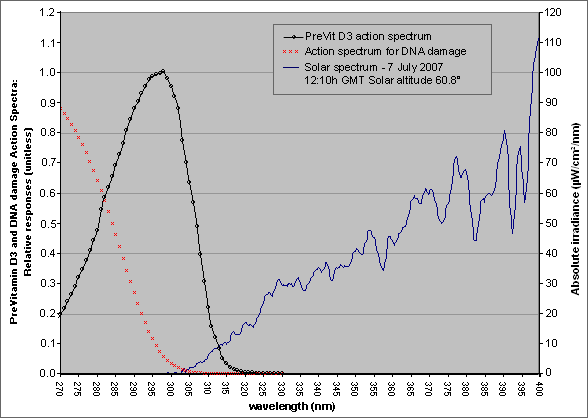 Fig.
7, left, shows an example of a solar UV spectrum (blue line).
was taken in full sunlight close to mid-day in Wales, UK,
with the sun at its highest point, close to the summer solstice.
Solar elevation was 60.8 degrees. The solar spectrum begins
at around 300nm and the irradiance rises fairly steadily
through the UVB wavelengths and continues to rise up through
UVA to visible light. Reptiles can actually see it from
about 350nm upwards. Fig.
7, left, shows an example of a solar UV spectrum (blue line).
was taken in full sunlight close to mid-day in Wales, UK,
with the sun at its highest point, close to the summer solstice.
Solar elevation was 60.8 degrees. The solar spectrum begins
at around 300nm and the irradiance rises fairly steadily
through the UVB wavelengths and continues to rise up through
UVA to visible light. Reptiles can actually see it from
about 350nm upwards.
The
black curve is the Pre-Vitamin D3 Action Spectrum (CIE 174:2006)
(4),
which shows the potential of a given wavelength to enable
vitamin D3 synthesis. As can be seen, this overlaps with
the solar spectrum up to about 315 - 320nm. Wavelengths
at around 298nm (where the action spectrum peaks) are most
efficient, but the amounts of this in sunlight are very
small indeed. Higher wavelengths are progressively less
efficient, until wavelengths above about 315nm can be seen
to have very little effect indeed. Having said that, there
is vastly more light at these higher wavelengths, so their
effect may be just as important as the tiny but more potent
amounts at around 300nm.
The
red curve is an action spectrum for DNA damage (adapted
from Setlow 1974)(5).
This shows the potential of a given wavelength to cause
injury and death to cells. From this graph, it can be seen
that the lowest wavelengths of sunlight, around 300 - 310nm,
do overlap this action spectrum.... no strong sunlight is
perfectly "safe" as we know... but most of the
solar UV spectrum lies outside of this "danger zone".
The action spectrum of photo-kerato-conjunctivitis (for
which we were unable to obtain data sufficient to plot on
a graph) in several species of mammal, including man, peaks
at around 270nm (6).This
suggests that it is not dissimilar to the action spectrum
for DNA damage which we have shown. Although no studies
appear to have been done on reptiles, there is no reason
to suppose their response would be markedly different.
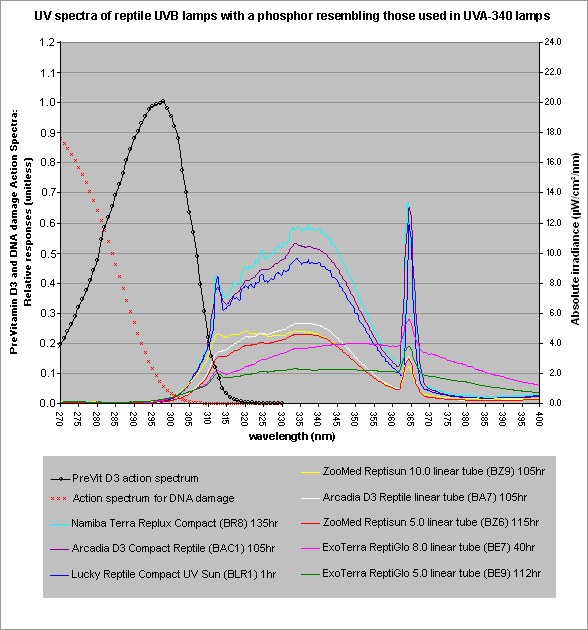 Figure
8 shows the UV spectra of a small selection of reptile UVB
lamps which as far as we know, have not been associated
with any photo-kerato-conjunctivitis or other health problems.
A quick comparison of the absolute irradiance of these lamp
spectra (all recorded at the very close range of 10cm.)
with that of the sunlight shows how feeble this irradiance
(even at 10cm) actually is; but it is not the total amount
of light we are concerned with, but rather the spectral
power distribution (SPD); the proportion of light at each
wavelength, i.e., the "shape" of the spectrum
compared to that of the sun. Figure
8 shows the UV spectra of a small selection of reptile UVB
lamps which as far as we know, have not been associated
with any photo-kerato-conjunctivitis or other health problems.
A quick comparison of the absolute irradiance of these lamp
spectra (all recorded at the very close range of 10cm.)
with that of the sunlight shows how feeble this irradiance
(even at 10cm) actually is; but it is not the total amount
of light we are concerned with, but rather the spectral
power distribution (SPD); the proportion of light at each
wavelength, i.e., the "shape" of the spectrum
compared to that of the sun.
All
have a similar threshold wavelength around 290 - 295nm,
followed by a steady rise up towards UVA. The shape of the
spectra is similar to that of sunlight up to about 340nm,
but then the UV output falls again and there is very little
higher wavelength UVA except for the mercury emission peak
at 365nm.
With
the exception of the ExoTerra lamps, these all have UV spectra
very similar to the lamp known as UVA-340.(7)
The typical spectrum of one of these lamps may be viewed
here
(external link; opens in new window; pdf
file - takes short time to load) This is widely used
in photobiological experiments and other tests requiring
artificial sunlight, since it is claimed to have the closest
possible resemblance to solar UV in the UVB portion of the
solar spectrum.(8)(9)
The spectrum is also very similar to that of human tanning
lamps with a high UVB content.(10)
Slight differences in the phosphor blends and in the composition
of the lamp glass cause some variations in the spectral
pattern, and affect the total amount of radiation produced,
as does the wattage of the lamp and its type (compact or
linear tube). The ExoTerra ReptiGlo lamps have a similar
spectrum to the others in the UVB region, but significantly
more UVA, especially higher-wavelength UVA. This would probably
make the lamp more visible to a reptile (with visual threshold
from 350nm)(11)
than other types.
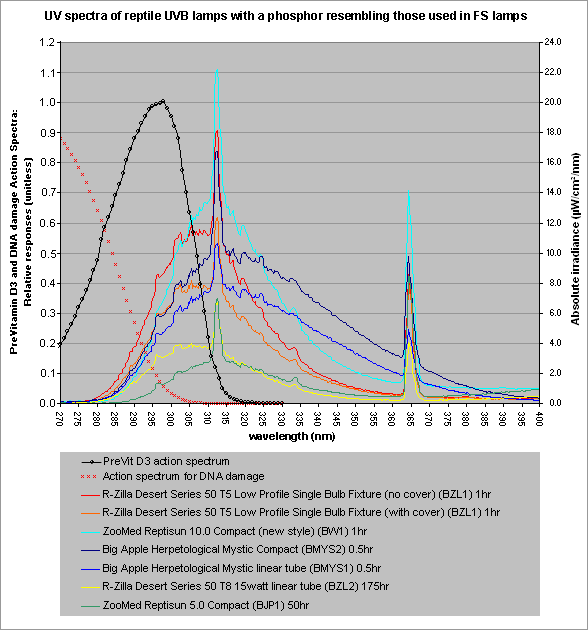 The
spectra of the fluorescent lamps which have been connected
in some way with cases of photo-kerato-conjunctivitis are
shown in Figure 9. All of these appear to utilise a very
different phosphor, which is generating low wavelength UVB
from a threshold as low as 275 - 280 nm. The
spectra of the fluorescent lamps which have been connected
in some way with cases of photo-kerato-conjunctivitis are
shown in Figure 9. All of these appear to utilise a very
different phosphor, which is generating low wavelength UVB
from a threshold as low as 275 - 280 nm.
This
is the typical UV spectrum of the phosphor used in so-called
"FS" lamps.(12)(13)
The typical spectrum of one of these lamps may be viewed
here
(external link; opens in new window; pdf
file - takes short time to load).
FS
lamps are used for testing the deterioration under UVB of
resistant materials such as roofing and car bodywork,(12)
and in older-style human clinical phototherapy lamps.(14)
Eye protection is always worn when any of these lamps are
used in clinical work. These lamps are never used as tanning
lamps or for cosmetic purposes.
Lamps
which contain a high proportion of this "phototherapy"
phosphor, and which have glass which does not block UVC,
emit radiation as low as 270nm. However, the lower wavelengths
are apparently attenuated by reducing the proportion of
phosphor in the blend and by use of different glass. The
Reptisun 10.0 lamp, for example, does not emit UVB below
280-285nm; the Big Apple Herpetological Mystic tube and
the R-Zilla Desert 50 Series T8 lamp emit UVB down to 275nm.
|
|
UV
Index Gradients: How much radiation do reptiles receive
from these lamps?
At the
height of summer, in the UK, full mid-day sunshine can produce
a UV Index (UVI) of about 9. In the tropics, mid-day sunlight
may reach levels of 10 - 14, but few animals are out and
about under such strong sunlight. A UVI above 16 -17 is
not naturally found in the most intense sunlight on the
face of the earth.
A small
number of recordings taken in the field, alongside basking
lizards in the tropics -usually seen in early to mid-morning
or from mid-afternoon onwards - suggest that reptiles which
bask in the sun choose times of day when UV levels are fairly
low - the highest recorded UVI in this study, for example,
was only 7.6.
Reptiles
which live in the shade, (in rainforest, for example) may
never expose themselves to as much as this; the UV Index
in rainforest shade may be less than 1.0 even at mid-day.
There
is insufficient evidence to make any definite recommendations
regarding an "ideal" UV Index gradient at a basking
spot. If the highest UVI in which a sun-loving lizard has
been seen basking is 7.6, then a maximum of 6 - 8 might
seem appropriate for that one species. No more can really
be said; but in the absence of any other evidence, it seems
reasonable to use figures like this as a temporary guide.
Certainly it would seem advisable to ensure no animal is
ever exposed to abnormal levels of UV radiation, which could
not occur anywhere in the animal's natural habitat.
Sets
of recordings were made from all the lamps on test, with
the UV Index Meter (Solarmeter 6.5) to construct charts
of the UV Index gradient created by each lamp. Measurements
were all taken at right angles to the lamp axis, halfway
down its length.
Figures
10 and 11 show the results for the Big
Apple Herpetological Mystic linear fluorescent tube, and
compact lamp, respectively, both before and after
burning in.
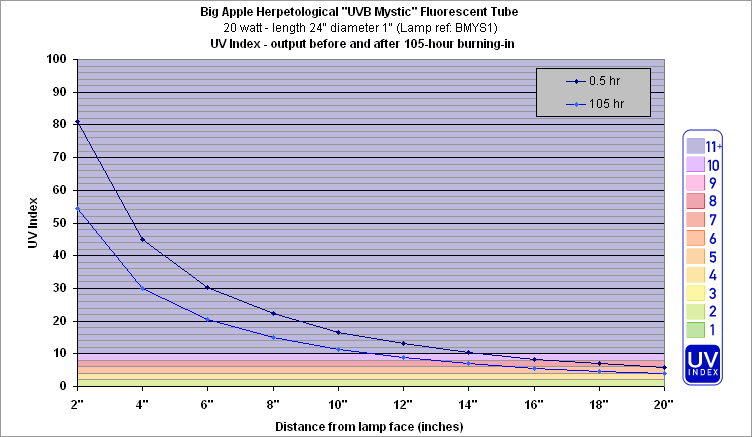
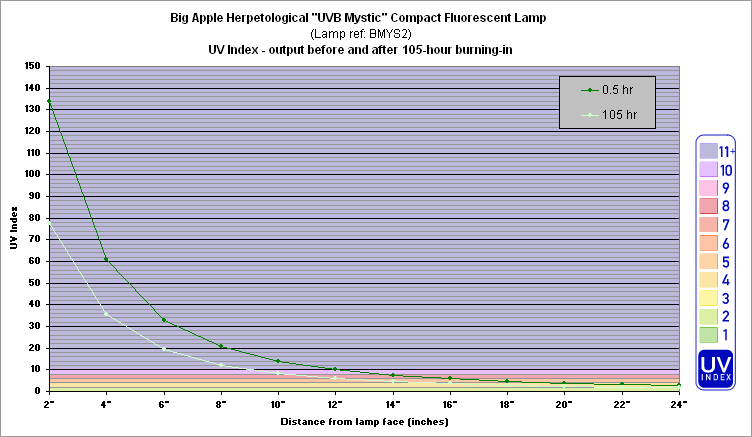
It
can readily be seen that at close range, both these lamps
are emitting extremely hazardous levels of radiation. At
6 inches, even after burning in, both lamps yield a UVI
higher than any sunlight on the face of the earth. At the
manufacturer's recommended minimum basking distance (10
inches) the UVI with the new linear tube we tested was 16.6
(that of the most extreme equatorial mid-day sun) and after
burning in, it was still 11.2 (that of tropical late morning
sun.) At 10 inches the UVI reading of the new compact lamp
we tested was 13.9 (equivalent to intense tropical mid-day
sun.)
If
a maximum UVI of 6.0 is required, a new linear tube must
be positioned at least 20 inches from the reptile, and a
new compact lamp needs to be at least 16 inches away.
Figure
12 shows the recordings for the R-Zilla
Desert 50 Series lamps on test.
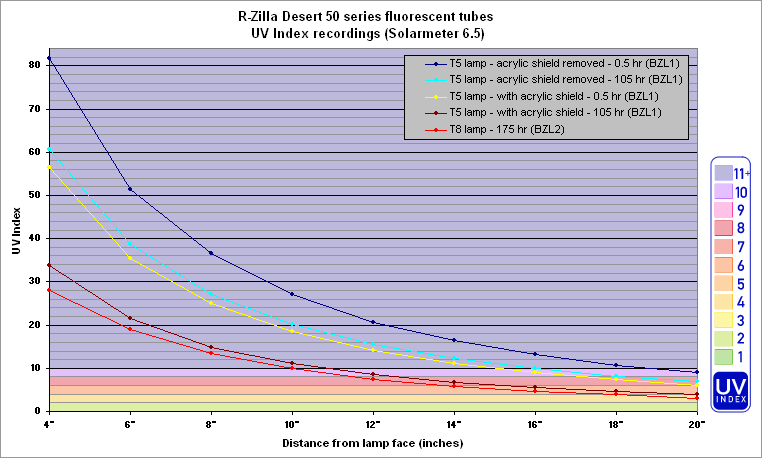
With
these lamps, too, at close range the radiation is very hazardous.
The brand new T5 lamp, with its removable acrylic cover
taken off, yields a UV Index of 81.6 at 4 inches. Animals
have been placed at this distance from the lamp by unsuspecting
owners. Even at 12 inches, a distance often recommended
as a maximum for other fluorescent UVB lamps, the new unshielded
T5 lamp is hazardous with an unearthly UV Index of 20.7.
Even at 18 inches, the level is still above a tropical 10.0.
Burning in does reduce the output considerably, of course,
but both the T8 lamp (at 150 hours) and the T5 lamp with
the acrylic shield in place (at 105 hours) still emit radiation
exceeding UVI 20 at 6 inches and UVI 10 at 10 inches.
Figure
13 is a complex chart as it plots the UVI gradients of all
the ZooMed Reptisun 10.0 lamps
which were on trial. The first 3 lamps shown in the key
were brand new samples; these, not surprisingly, have the
highest output. Lamps BW3, 4 and 5 were all lamps known
to have caused photo-kerato-conjunctivitis in reptiles.
The final two lamps (BZC1 and MB2) were Reptisun 10.0 compact
lamps of an earlier design; these had a much lower UVB output
even when brand new.
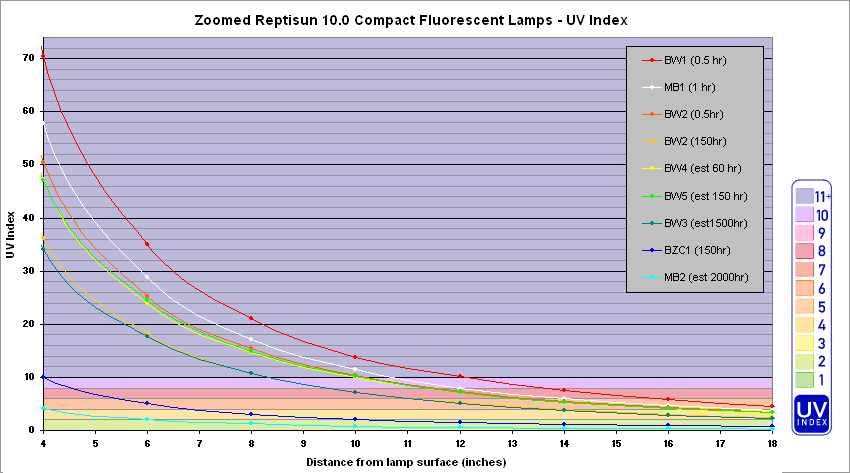
Once
again, even well burned-in lamps produce unearthly levels
of UV radiation further than six inches from the side of
the lamp. The new lamp with the highest output would need
to be placed 16 inches above a reptile for the UVI to be
below 6. Interestingly, the manufacturer's minimum recommended
distance for a new Reptisun 10.0 lamp (positioned horizontally,
like this, above the reptile with no mesh or reflector)
is 23 - 25 inches, according to their new information sheet.
This, according to our recordings (not shown on the chart)
would yield a UVI of about 2.3.
The
last chart in this series is that for the ZooMed
Reptisun 5.0 Compact lamps. (Figure 14)
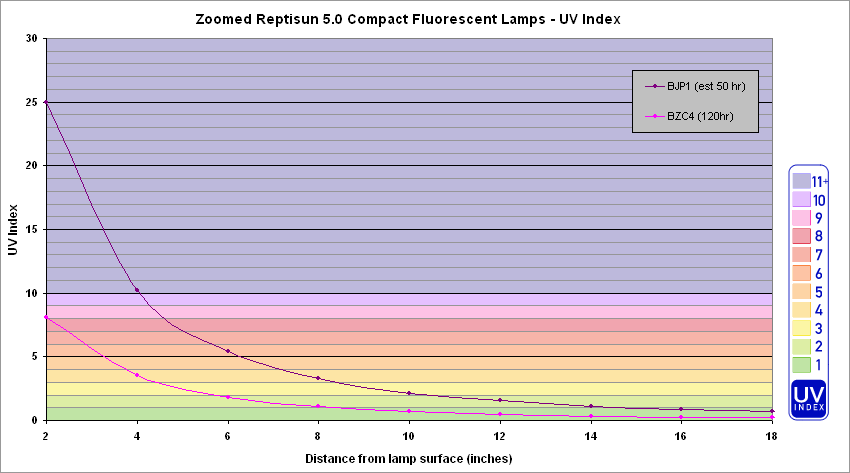
The
first lamp, BJP1, caused photo-kerato-conjunctivitis in
a small group of hatchling lizards which could approach
to about 4 inches. Although the output of this lamp is far
lower than that of a Reptisun 10.0, it it not insignificant,
and the UVI climbs rapidly to hazardous levels at ditances
closer than 4 inches.
The manufacturer's minimum recommended distance for a new
Reptisun 5.0 lamp set up in this way is 17 - 19 inches.
This would give a UVI of only about 0.8 with lamp BJP1.
The
second lamp (BZC4) was of the older design, and had a lower
output although it has also been in use for considerably
longer, making a comparison difficult.
It
is tempting to assume that all that is necessary, to enable
these lamps to be used safely, is to calculate "safe"
minimum basking distances with what seems to be a suitable
UV Index, and ensure that these are always used. Although
this approach should reduce the irradiation to a level where
photo-kerato-conjunctivitis is unlikely, it may not be a
long-term solution.
It
is important to remember that the UV light which is producing
these high UV Indices contains non-solar wavelengths.
The effect of non-solar radiation on living cells is different
to that of sunlight. Even using the UV Index as a guide
for a safe basking distance may not be appropriate with
these wavelengths in the beam. This will be considered further
in the discussion.
|
|
The
Effect of Reflectors and Domes
In the
vivarium, the shape of the UVB beam from a lamp, and the
UVB gradient which it creates, is very important. The beam
must be wide enough for the reptile to place most, if not
all of its body within the zone of effective UVB radiation
at a suitable basking distance.
The
shape of the beam from a fluorescent lamp, which is a relatively
diffuse light source, is determined by the size and shape
of the lamp and whether or not a reflector of any type is
fitted.
Aluminium
is an extremely good reflector of UV light. Our previous
studies have demonstrated that simple strip reflectors
fitted behind linear fluorescent tubes can double the effective
amount of UVB beneath the lamp. The use of a strip reflector
or aluminium lamp housing behind any of these lamps (compact
or linear tube) might therefore be problematical.
An even
more powerful increase is seen if an aluminium dome reflector
is used. We first investigated the effect of placing compact
lamps in dome reflectors of different types in 2005. Our
first tests showed that the output was more than six times
greater beneath a compact lamp, if either a polished aluminium
or a brushed aluminium dome reflector was fitted. Obviously,
an increase of that magnitude with a lamp that was already
emitting very high levels of UVB could be dangerous.
Iso-irradiance
charts ("spread charts")
for both total UVB output (µW/cm²) and UV Index were
therefore constructed according to the method previously
devised by FB, for one recently burned-in new-style
Reptisun 10.0 lamp (ref. BW2), with no reflector, and also
when fitted with four different types of dome reflector.
The
type of reflector has a profound effect upon the shape of
the beam and the intensity of the UVB under the lamp.
With
no reflector, the beam is, roughly speaking, an extension
of the shape of the lamp into the air around it, forming
a flattened sphere with a UVB gradient increasing sharply
as the lamp is approached.
|
Fig.
15(a) and (b):
ZooMed
Reptisun 10.0 Compact Lamp (no dome)
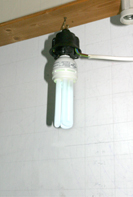
|
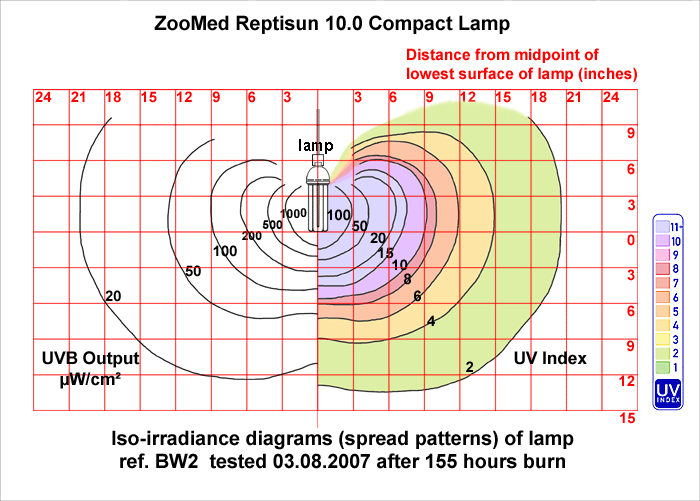 |
When
the lamp is inside a white painted porcelain dome such as
the ZooMed 10.5inch brooder dome, there is little change
in the shape of the beam. The white surface does not reflect
UVB light. The blocking of the upper parts of the lamp from
view actually reduces the overall output slightly, below
and to the sides of the lamp. (Fig. 16(b) )
|
Fig.
16(a) and (b):
ZooMed
Reptisun 10.0 Compact Lamp in ZooMed 10.5in dome with
white porcelain interior
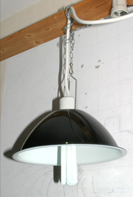
|
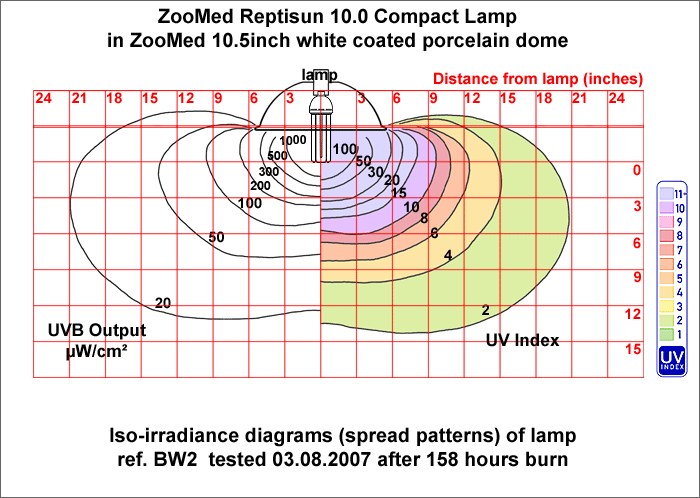 |
With
the aluminium domes, the situation is very different. (figs.
3 - 5)
|
Fig.
17(a) and (b):
ZooMed
Reptisun 10.0 Compact Lamp in deep 8in. brushed aluminium
brooder dome
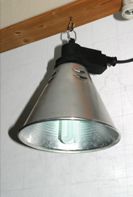
|
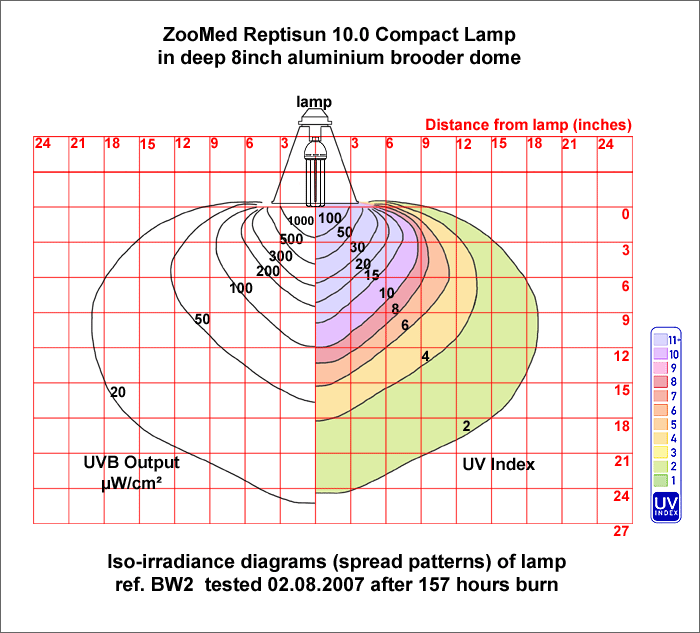 |
|
Fig.
18(a) and (b):
ZooMed
Reptisun 10.0 Compact Lamp in extra large 10.5in aluminium
dome
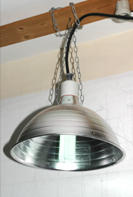
|
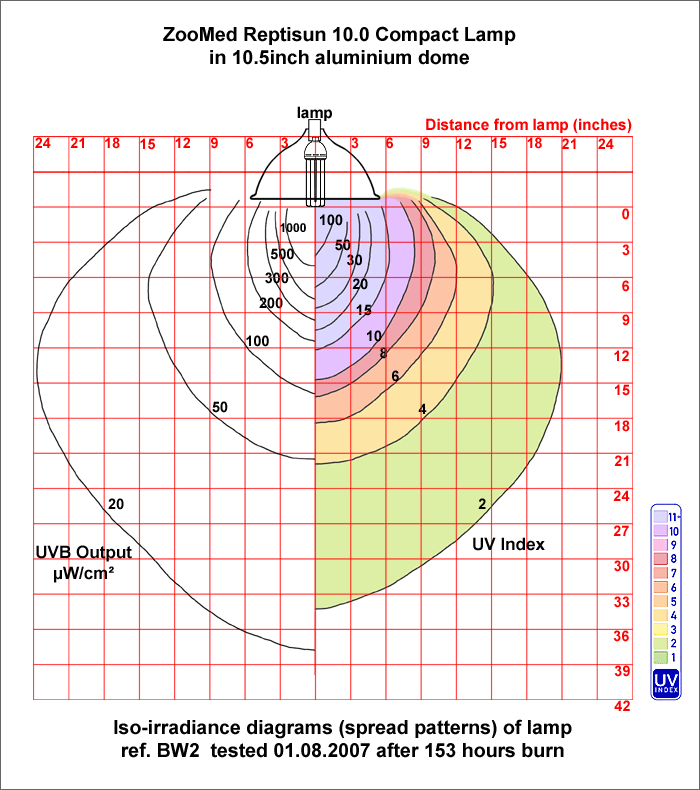 |
|
Fig.
19(a) and (b):
ZooMed
Reptisun 10.0 Compact Lamp in Pifco 8.5in aluminium
dome
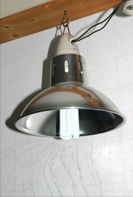
|
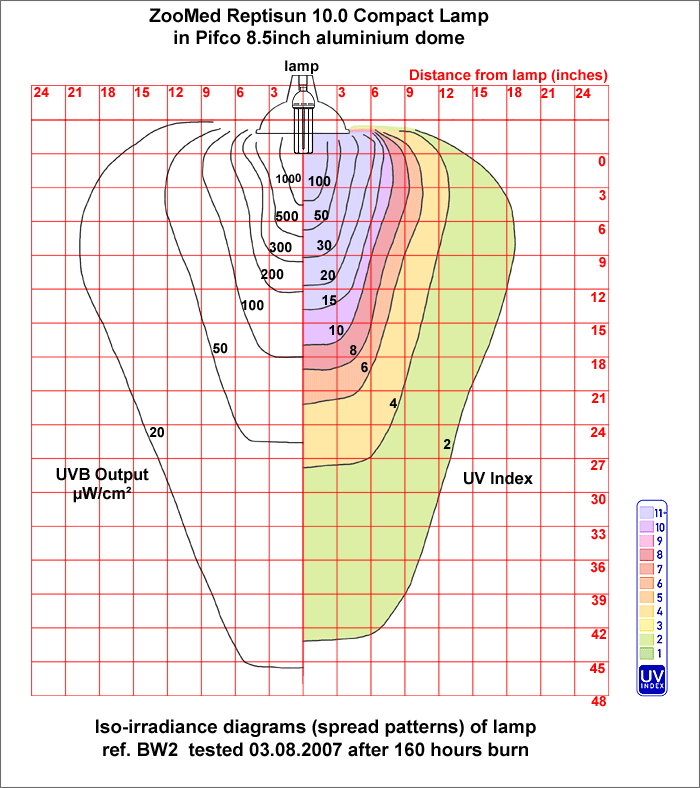 |
Compact
fluorescent lamps have a comparatively large surface area.
When most of the light from all sides of such a lamp is
gathered and reflected downwards, as it is in a dome reflector,
the resulting beam may be extremely intense. When the dome
is shaped like a parabola, and the aluminium is polished,
as with the Pifco 8.5inch dome, the effect is even more
pronounced as a directional beam is created beneath the
dome. (Fig. 19(b))
Measurement
of the UV Index gradient directly beneath the lamp in each
situation reveals the increase in intensity produced by
the aluminium reflectors. From this data, the percentage
increase in UV index produced by each dome may be calculated
(Figure 20).
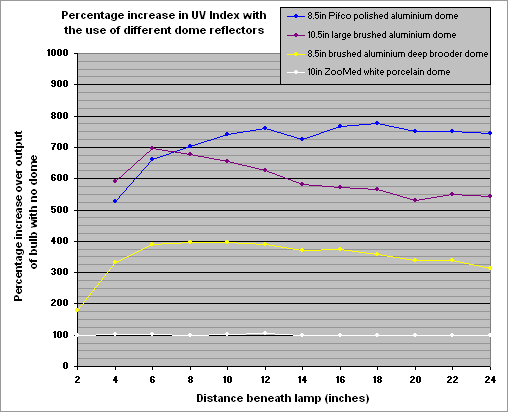 The
different shape of each aluminium reflector produces a different
effect at any given distance, but 12 inches below the lamp,
the parabolic shape of the Pifco dome amplifies the UVI
to 762% of the UVI of the bulb with no dome, measured at
the same distance below the lamp; the large brushed aluminium
dome gives a 627% increase, and the deep aluminium dome
increases it by 388%. The
different shape of each aluminium reflector produces a different
effect at any given distance, but 12 inches below the lamp,
the parabolic shape of the Pifco dome amplifies the UVI
to 762% of the UVI of the bulb with no dome, measured at
the same distance below the lamp; the large brushed aluminium
dome gives a 627% increase, and the deep aluminium dome
increases it by 388%.
These
enormous increases are not something that most people would
expect. The use of the popular "clamp lamp" type
of fixtures, which typically hold the lamp about six inches
above the edge of the tank to which they are fixed, rarely
raise the lamp more than 8 - 10 inches above an elevated
basking spot, such as a log or rock, in the vivarium below.
Any
domes with aluminium interiors should only be used with
extreme caution, with high-output lamps. The effect varies
widely with the exact size and shape of the dome, so it
is difficult to offer specific advice about basking distances.
|
|
UVC
Recordings
with the Solarmeter 8.0 broadband UVC radiometer (240 -
280nm) taken from every lamp in the trial gave the results
shown in Figure 21 (below).
| Fig.
21: UVC output : ZooMed Reptisun Compact Fluorescent
Lamps (µW/cm²) |
| |
distance
from bulb surface (inches) |
| |
2 |
4 |
6 |
8 |
| ZooMed
Reptisun 10.0 lamps -new style |
|
|
|
|
| BW1
(0.5 hr) |
3 |
1 |
0 |
0 |
| BW2
(0.5 hr) |
2 |
1 |
0 |
0 |
| BW2
(150 hr) |
1 |
0 |
0 |
0 |
| MB1
(1 hr) |
2 |
1 |
0 |
0 |
| BW4
(est. 60 hr) |
2 |
1 |
0 |
0 |
| BW5
(est. 150 hr) |
2 |
1 |
0 |
0 |
| BW3
(est. 1500 hr) |
1 |
1 |
0 |
0 |
| ZooMed
Reptisun 10.0 lamps - old style |
|
|
|
|
| BZC1
(150 hr) |
0 |
0 |
0 |
0 |
| MB2
(est. 2000 hr) |
0 |
0 |
0 |
0 |
| ZooMed
Reptisun 5.0 lamps |
|
|
|
|
| BJP1
(est. 50 hr) |
0 |
0 |
0 |
0 |
| BZC4
(120 hr) |
0 |
0 |
0 |
0 |
| Big
Apple Herp. Mystic fluorescent tube
|
|
|
|
|
| BMYS1
(0.5 hr) |
1 |
0 |
0 |
0 |
| BMYS1
(105 hr) |
1 |
0 |
0 |
0 |
| Big
Apple Herp. Mystic compact lamp |
|
|
|
|
| BMYS2
(0.5 hr) |
2 |
1 |
0 |
0 |
| BMYS2
(105 hr) |
0 |
0 |
0 |
0 |
| R-Zilla
Desert 50 Series Fluorescent Lamps
|
|
|
|
|
| BZL1
- T5 - acrylic shield removed (1hr) |
2 |
1 |
1 |
0 |
| BZL1
-T5 - acrylic shield removed (105 hr) |
2 |
1 |
1 |
0 |
| BZL1
-T5 - with acrylic shield (1 hr) |
1 |
0 |
0 |
0 |
| BZL1
-T5 - with acrylic shield (105 hr) |
1 |
0 |
0 |
0 |
| BZL1
-T8 (175 hr) |
1 |
0 |
0 |
0 |
Some
of these lamps do emit traces of UVC, which correspond to
the high-wavelength UVC (from 275nm - 280nm) seen on the
spectrograms. However, this UVC output is low and at more
than a few inches from the lamp, seems unlikely to be very
significant.
Continue
to: discussion
Return to: beginning
of report
|
|
© 2007 UVGuide.co.uk
|


















 The
ZooMed Reptisun 10.0 Compact Lamp
is described as " ideal for all desert and basking reptiles"
and the 5.0 Compact Lamp
as "ideal for all tropical basking reptiles". No information
is available on the box or on the ZooMed website regarding
any recommended basking distances. ZooMed are now including
a comprehensive information sheet in the packaging of all
new stock, but this was not inside any of the new boxes
we obtained back in April. Hence it seemed, at first, that
maybe the lamps were just being placed too close. However,
we measured the output of their lamps with a broadband UVB
meter (Solarmeter 6.2) and found total UVB levels not unlike
those found in natural sunlight, at distances which caused
eye problems in reptiles. For example, a brand new ZooMed
Reptisun 10.0 Compact Lamp gave a reading of 306
µW/cm² at 6 inches. Reptiles have been recorded basking
and foraging in sunlight in the wild at similar levels (up
to 322 µW/cm²). The reading at 10
inches was 121 µW/cm².
The
ZooMed Reptisun 10.0 Compact Lamp
is described as " ideal for all desert and basking reptiles"
and the 5.0 Compact Lamp
as "ideal for all tropical basking reptiles". No information
is available on the box or on the ZooMed website regarding
any recommended basking distances. ZooMed are now including
a comprehensive information sheet in the packaging of all
new stock, but this was not inside any of the new boxes
we obtained back in April. Hence it seemed, at first, that
maybe the lamps were just being placed too close. However,
we measured the output of their lamps with a broadband UVB
meter (Solarmeter 6.2) and found total UVB levels not unlike
those found in natural sunlight, at distances which caused
eye problems in reptiles. For example, a brand new ZooMed
Reptisun 10.0 Compact Lamp gave a reading of 306
µW/cm² at 6 inches. Reptiles have been recorded basking
and foraging in sunlight in the wild at similar levels (up
to 322 µW/cm²). The reading at 10
inches was 121 µW/cm². 
 The
Big Apple Herpetological Mystic
lamps are claimed to be "Rated #1 most powerful
UVB emitting fluorescent reptile light" and to "produce
as much UVB as the highest quality UVB mercury vapor bulbs".
The
Big Apple Herpetological Mystic
lamps are claimed to be "Rated #1 most powerful
UVB emitting fluorescent reptile light" and to "produce
as much UVB as the highest quality UVB mercury vapor bulbs".

 No
minimum basking distance is specified regarding the T8-size
linear tube. We recorded total UVB levels from a 15 watt
tube that had been burned-in for 150 hours as 69
µW/cm² at 10 inches.
No
minimum basking distance is specified regarding the T8-size
linear tube. We recorded total UVB levels from a 15 watt
tube that had been burned-in for 150 hours as 69
µW/cm² at 10 inches.  Fig.
7, left, shows an example of a solar UV spectrum (blue line).
was taken in full sunlight close to mid-day in Wales, UK,
with the sun at its highest point, close to the summer solstice.
Solar elevation was 60.8 degrees. The solar spectrum begins
at around 300nm and the irradiance rises fairly steadily
through the UVB wavelengths and continues to rise up through
UVA to visible light. Reptiles can actually see it from
about 350nm upwards.
Fig.
7, left, shows an example of a solar UV spectrum (blue line).
was taken in full sunlight close to mid-day in Wales, UK,
with the sun at its highest point, close to the summer solstice.
Solar elevation was 60.8 degrees. The solar spectrum begins
at around 300nm and the irradiance rises fairly steadily
through the UVB wavelengths and continues to rise up through
UVA to visible light. Reptiles can actually see it from
about 350nm upwards.  Figure
8 shows the UV spectra of a small selection of reptile UVB
lamps which as far as we know, have not been associated
with any photo-kerato-conjunctivitis or other health problems.
A quick comparison of the absolute irradiance of these lamp
spectra (all recorded at the very close range of 10cm.)
with that of the sunlight shows how feeble this irradiance
(even at 10cm) actually is; but it is not the total amount
of light we are concerned with, but rather the spectral
power distribution (SPD); the proportion of light at each
wavelength, i.e., the "shape" of the spectrum
compared to that of the sun.
Figure
8 shows the UV spectra of a small selection of reptile UVB
lamps which as far as we know, have not been associated
with any photo-kerato-conjunctivitis or other health problems.
A quick comparison of the absolute irradiance of these lamp
spectra (all recorded at the very close range of 10cm.)
with that of the sunlight shows how feeble this irradiance
(even at 10cm) actually is; but it is not the total amount
of light we are concerned with, but rather the spectral
power distribution (SPD); the proportion of light at each
wavelength, i.e., the "shape" of the spectrum
compared to that of the sun. The
spectra of the fluorescent lamps which have been connected
in some way with cases of photo-kerato-conjunctivitis are
shown in Figure 9. All of these appear to utilise a very
different phosphor, which is generating low wavelength UVB
from a threshold as low as 275 - 280 nm.
The
spectra of the fluorescent lamps which have been connected
in some way with cases of photo-kerato-conjunctivitis are
shown in Figure 9. All of these appear to utilise a very
different phosphor, which is generating low wavelength UVB
from a threshold as low as 275 - 280 nm. 














 The
different shape of each aluminium reflector produces a different
effect at any given distance, but 12 inches below the lamp,
the parabolic shape of the Pifco dome amplifies the UVI
to 762% of the UVI of the bulb with no dome, measured at
the same distance below the lamp; the large brushed aluminium
dome gives a 627% increase, and the deep aluminium dome
increases it by 388%.
The
different shape of each aluminium reflector produces a different
effect at any given distance, but 12 inches below the lamp,
the parabolic shape of the Pifco dome amplifies the UVI
to 762% of the UVI of the bulb with no dome, measured at
the same distance below the lamp; the large brushed aluminium
dome gives a 627% increase, and the deep aluminium dome
increases it by 388%.